Nixeus NX-VUE27 27" Monitor: High Resolution for the Masses
by Chris Heinonen on September 20, 2012 6:10 PM ESTColor Quality
I didn’t have a driver CD or anything else to use for a default ICC profile for the Nixeus, so the initial measurements were done at 200 nits in standard mode, as it was the closest to the D65 white point of the sRGB standard.
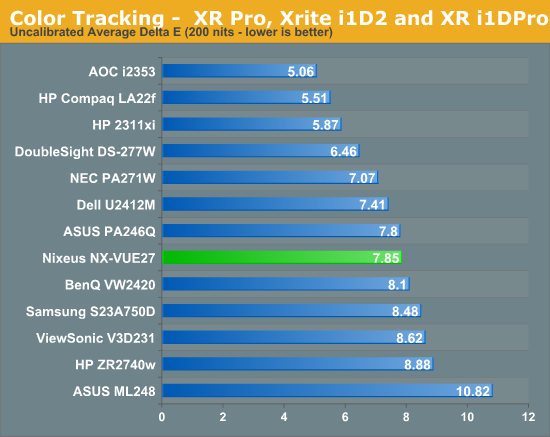
Straight out of the box the results are about par for a 27” display. With an average dE across the Gretag Macbeth chart of 7.85, this falls in as worse than the NEC and DoubleSight models I saw, but better than the HP that has been my favorite 27” to this point for its balance of price and performance.
The main issue with the uncalibrated performance is the grayscale numbers. Most of us have white backgrounds on webpages, Word, Excel, email, and all our other programs, so an error here is more visible that a shade of blue might be. This isn’t any worse than most other displays I have reviewed, but I wish it were better.

Once calibrated, the numbers really fall into line with everyone else. The average dE is 1.78, which is almost identical to the HP ZR2740w that scored 1.76. The grayscale error comes down to be between 1.0 and 1.5 across the whole scale, so you really won’t be able to notice a color tint at all. The errors all occur in those shades of blue that are always troublesome, but the rest of the numbers really fall into line here. This is impressive considering this display costs $300 less than its competitors.
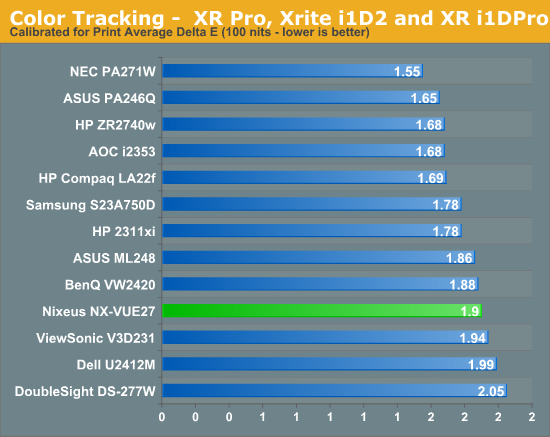
With print work the numbers aren’t quite as good. Set for 100 nits, we get a dE of 1.90 that begins to lag behind the HP, and really lags behind the far more expensive NEC PA271W. Nothing here is horrible, but it does fall a little behind the competition here. Most likely it won’t be noticeable in real world use, but for professionals that often want a dE of 1.0 or less, having a dE of closer to 2 might not cut it.
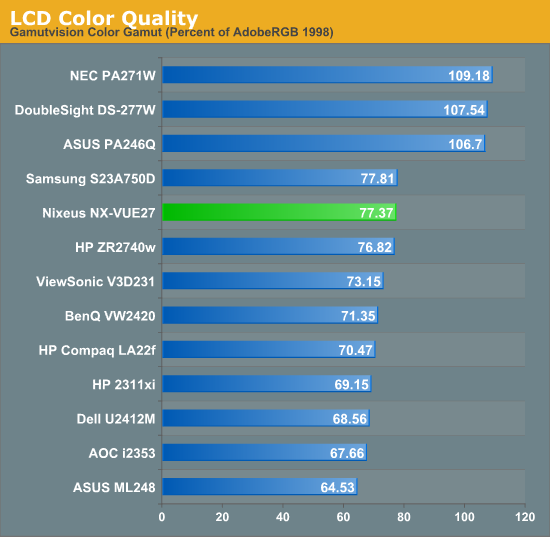
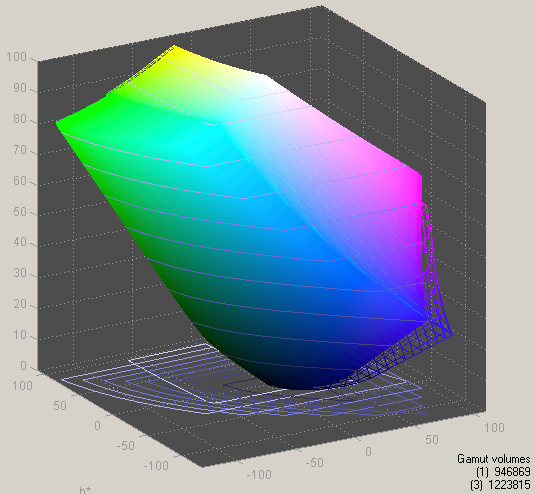
The coverage of the Nixeus panel is really no surprise at all. Since all 27" displays seem to be using a panel from LG with either LED or CCFL backlighting, it's the backlighting that determines the color gamut. Here we are incredibly close to the same coverage as the HP, both of which are covering virtually the entire sRGB gamut. As before, if you want a larger gamut, you'll need to get a CCFL or RGB-LED backlight; either one will push the cost up significantly right now, as well as the power consumption (and in the case of CCFL, the size).



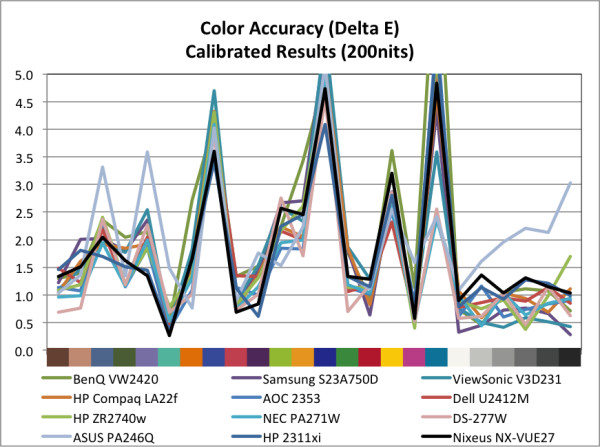
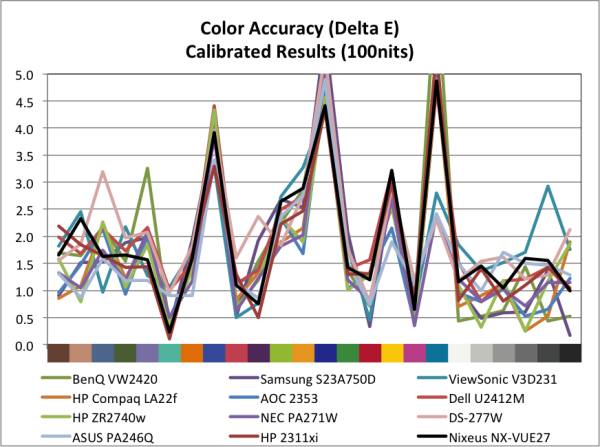








66 Comments
View All Comments
Death666Angel - Friday, September 21, 2012 - link
Or AMD 7xxx. :)Penti - Friday, September 21, 2012 - link
No, just no. Only 3 GHz HDMI 1.4a support above 1920x1200. Don't confuse the two, the monitor does not support it. DVI-DL or DP that rules here. The Nixues might accept a higher res signal over HDMI but it doesn't have the bandwidth to handle it so it causes issues. DP or DVI-DL recommended and is the only one's supported by the vendor. It's basically like trying to run SL-DVI at a higher res then specced here. Skip HDMI-connections whenever you can, skip notebooks with only HDMI whenever you can if you want to run over 1920x1200. Even if you happen to have stuff supporting HDMI 1.4a 3GHz (3GHz part is vital here) in your portable stuff the monitor isn't yet supporting it. They need a new generation of chips driving the displays. GCN and Kepler might be practical if you like to run above 2560x1600 though, but most monitors still requires two DP-connections for 3840x2160/2400 when they don't have true DP1.2 support. There isn't really much of any hardware around to support all the other DP1.2 features either such as daisy chaining.HDMI is essentially useless here unless it can scale your console (1280x720/1920x1080) good enough on that screen to be usable and correctly viewed. VGA isn't really any use either. You simply have to use a lower res screen if you don't have access to DL-DVI and or DP supporting stuff.
atotroadkill - Friday, September 21, 2012 - link
Thanks for the clarification... I currently use the displayport connection from my GTX 670 to my NX-VUE27... before when I was using HDMI 1.4 I did experience artifacts and some sync issues at 2560x1440. After that I tried Dual Link DVI but I couldn't see my bios... but after switching to Displayport those issues went away.Despoiler - Thursday, September 20, 2012 - link
Too much processing lag. 2 FRAMES!!! Glad I held off. That is a non-starter.atotroadkill - Thursday, September 20, 2012 - link
"Because I have to run at a non-standard resolution compared to the Nixeus, you might see some additional lag being added to the input than if you ran natively, but there is no way for me to actually test the native input lag time. There is also no way on the Nixeus to set a 1080p image to be centered and not scaled, which might reduce lag by doing 1:1 mapping and bypassing the scaler but at the expense of only using part of the screen."The 2 Frames and processing is because of Non-Native resolution testing and testing it 1080p...so if you are gaming at 1080p on the monitor then yes it will bother you - and gaming on this monitor at 1080 you shouldn't get this monitor anyways.
I'm using it at 2560x1440 playing BF3 and it has no affect on my shooting and timing (with V-SYNC off)
abhaxus - Friday, September 21, 2012 - link
I wonder about this also. Since the author doesn't have a CRT capable of 1440p for reference, why not just compare the input lag using the HP as a reference at 1440p? Seems like a solution that might get answers for those of us who are quite interested in this monitor. I suspect it's as you say, that without scaling it can do ok.cheinonen - Friday, September 21, 2012 - link
Well, testing that would require that I still have the HP monitor, but since I didn't buy it, that isn't really an option for me to do. The only CRTs out there that can do 1440p are probably projectors with 9" CRTs, and unfortunately installing a 100+ lb. projector, not to mention the cost of finding one in great shape to test it, precludes that.trynberg - Friday, September 21, 2012 - link
Not that I expect you to get one, but there are plenty of 19-21" CRTs out there that can do 2048X1536 resolution for dirt cheap...I have two sitting at home right now (19" Mitsubishi and 21" Sun/Sony).cheinonen - Friday, September 21, 2012 - link
It has to be 2560x1440, though, for the exact same native resolution, and something that can do that is incredibly hard to find.Sabresiberian - Friday, September 21, 2012 - link
Hmm well okay the Sony GDM FW900 runs at 2304x1440, not 2560, but wouldn't that give you better results?(I'm not sure this is a huge issue, as long as your testing methodology is consistent across LCD displays.)